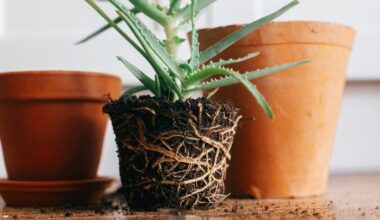You go home with your new purchase, what are you going to do with your new plant? Here’s what to do right after you buy a plant.
It is therefore important to repot the plants that have just been purchased, as they have usually reached the maximum size for the pots in which they are sold.
Contents
When should a plant be repotted?
When purchasing, choose a jar slightly wider than the original one (between 1 and 2 inches more in diameter). Do not buy a model that is too large. The roots will not find their marks and your plant will not like it. It is best to repot it as it grows.
Plant or repot as soon as possible.
It is better to take care of the plant right away.
Plant it directly in the garden in an area that perfectly suits its needs as soon as you arrive, weather conditions permitting. Remember to hydrate the root ball beforehand by soaking it in water at room temperature ¼ one hour before planting.
If the plant is bare-rooted, keep it well wrapped to prevent the roots from drying out; spray water on the roots as needed. If planting is delayed for several days, put it in a gauge.
If it is an indoor plant, check its health and the possible presence of pests or diseases that you may have missed when you bought it. Treat it and place it in quarantine if necessary so that it does not contaminate your other plants because in interior, that goes very quickly!
If the plant is in good health, check the state of the root system: if the pot is too narrow, repot the plant in a larger pot filled with a mixture adapted to its needs. A terracotta pot is always preferable, it ensures better gas exchanges.
Caution: if your plant is in buds or flowers, postpone the repotting to later in order not to cause their fall.
After planting or repotting
Once your plant has been set up in a location and exposure that suits its needs, take care to water it often to ensure its recovery. However, the soil should never be soaked to prevent root rot.
Never leave water in pot holders or bowls for the same reason, except for a few rare plants that support it like papyrus for example, but you will have made sure to ask beforehand!
What if I can’t repot right away?
It is sometimes impossible to install a plant in the garden in the hours following its purchase: lack of time, unfavorable weather conditions (heavy rain, frost, intense heat, snow…).
In this case, don’t panic!
If it is hot: Install your plant in the shade on the terrace even if it is a plant that enjoys full sun. You will accustom it only gradually to the full sun, especially if it was on sale on a stall indoors, otherwise the leaves may burn. Don’t forget to water it if the substrate is dry!
If it is cold: place your plant in a bright and sheltered room especially if it freezes. It is not uncommon to have a crush in early spring on a frozen plant (surfinia, New Guinea impatiens, tomato, melon …). It will be necessary to wait before installing it in the garden that any risk of frost has passed. During all this time, do not forget to water it according to its needs but never in excess.
Concerning trees and shrubs, the technique of gauging is a very interesting alternative to keep them until planting.
During transport after purchase of the plant
The transport of the plant
Once the plant has been purchased, the transport conditions are paramount to avoid damage. If you are accompanied, it is preferable to leave the plant between the passenger’s feet so that it is well wedged. If you have to place it in the trunk or on the rear seats, be sure to place it so that the stems do not break and the plant does not fall out at every turn.
Do not crush it between your shopping bags, do not put anything on it, and get home as soon as possible so that it does not suffer from thermal shock (hot or cold) behind the windows of the vehicle. During the trip, avoid creating a big draught by opening all the windows wide; your plant wouldn’t like it!
On the way home
Again, do not leave the plant in the car. Behind windows in the sun, it could very quickly “fry” and take a heat stroke, it will then be very hard to recover it. In the same way if it is very cold, especially if it is about a non-rustic or tropical plant.
Summary
Logically, any wise gardener should choose his plants according to what he can offer them in terms of light, soil and time to devote to them and not impulsively, but this would take away a lot of fun and leave little chance for change and discovery!
Between reason and passion, the gardener’s heart sometimes swings… Replacing reason by adaptation or even acclimatization is then a solution!









